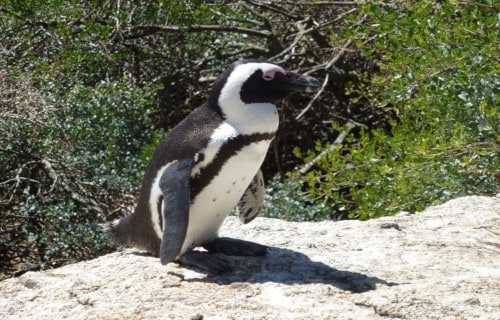
We hope that each of you, our readers, will enjoy and appreciate this article we present about these 3 Bewildering Birds of Africa. It was certainly our great pleasure to compile the information for you. May it provide you with both education and increased awareness.
Certainly, however, these few species listed herein represent only a portion of the natural wonders appearing in the region. It’s our belief, though, that they serve as excellent examples of the marvels found here. Check out some of our other articles for similar species.
Shoebill
Shoebill Facts
- Leading off this article about these 3 Bewildering Birds of Africa we give you the astounding creature known by the simple term of Shoebill.
- The term used herein serves as the most frequently used of the common names for a stork-like bird, renowned for its size. It also has alternate names by which it’s known, though. These include the whalehead, whale-headed stork, and shoe-billed stork.
- Professionals, such as reaserchers, meanwhile, typically refer to the animal by its formal scientific name. That’s the comparatively simple term of Balaeniceps rex. Regardless of the term used to refer to it, however, it’s a fascinating product of evolution.
- Local populations long knew of it of course. The renowned British ornithologist, John Gould made the first known official recognition of it as a separate and distinct species, though. This scientifically noteworthy event further occurred in the year 1850.
- Sadly, however, this marvel of Nature appears to be dwindling in numbers. That appears to hold true throughout the entirety of its range. Current estimates by researchers place its total population at somewhere between 5,000 – 8,000 adult individuals.
- Due to these numbers, along with other factors, the IUCN presently lists the remarkable bird as Vulnerable. That status is reflected on the organization’s Red List of Threatened Species. Presently, habitat destruction’s considered its greatest threat.
- Other dangers also threaten the amazing Shoebill, though. Though it enjoys a protected status, illegal hunting continues to pose a danger. The fabulous avian also doubtless faces the same concern as most other species today, that of of climate change.
Shoebill Physical Description
Unlike many species, the intriguing Shoebill garners attention due to more than one physical attribute. In point of fact, several physical qualities distinguish this distinctive animal. That fact alone sets the creature apart from the great majority of birds throughout the world.
Its great physical size, though, easily ranks as one of these distinguishing traits. That’s because it’s a tall bird, to put it mildly. That’s due to the fact that mature adults stand an average of 43 – 55 in (110 – 140 cm) in height. Excceptional specimens reach 60 in (152 cm).
It’s also quite long, to the amazement of many. From tail to break, this measurement reaches as much as 55 in (140 cm). Most, though, remains somewhat smaller than that. It also boasts a very impressive wingspan. This, in fact, averages 7.5 – 8.5 ft (228 – 260 cm).
The bird also displays a moderate degree of the physiological trait of sexual dimorphism. In its case, however, this trait manifests itself in terms of bulk since both genders reach the same general size. Specifically, males tend to be slightly larger than females of the species.
More precisely, males of the species typically reach a weight of roughly 12 lb (5.6 kg). Females, though, rarely exceed 11 lb (4.9 kg). Otherwise, the genders appear virtually indistiguishable. The plumage tends to be mainly a blue-gray shade, with darker patches.
The most distinguishable remaining physical characteristic of the Shoebill, however, is the source of its common name. That’s the greatly oversized bill, said by some to resemble a shoe. It’s not only quite thick, but averages 7.4 – 9.4 in (18.8 – 24 cm) in length.
- Kingdom: Animalia
- Phylum: Chordata
- Class: Aves
- Order: Pelicaniformes
- Family: Balaenicipitidae
- Genus: Balaeniceps
- Species: B. rex
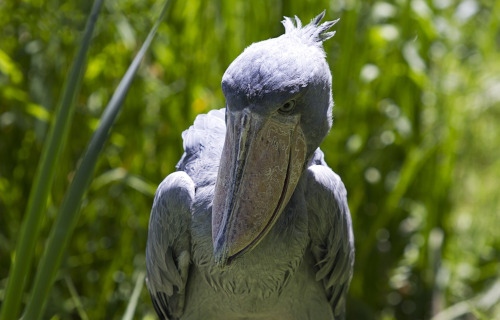
Shoebill Distribution, Habitat, and Ecology
Unfortunately for those who appreciate the amazing creatures of Nature, the Shoebill has a somewhat limited range of habitation. That’s due to the fact that it only appears to live in a small portion of one continent. Evidence indicates it once had a greater range, though.
The continent it appears on, however, likely comes as no surprise. That’s because it evolved as native to a small portion of the continent of Africa. Even there, though, its range remains limited. It only resides in the central tropical parts of that remarkable region.
More precisely, the fascinating bird lives in a range that begins in southern Sudan. From there, that zone extends through Congo, Rwanda, Uganda, and parts of Zambia and Tanzania. The majority of its population, however, lives in the West Nile sub-region.
In all regions it appears in, though, it displays strong preferences for its type of habitat. Due to those preferences, virtually all specimens appear in either areas of freshwater swamps or wetlands. It mainly prefers areas where the water’s poorly oxygenated.
The reason for that, though, lies in the nature of its diet. Like its numerous relatives, the Shoebill feeds as a carnivore. Its primary diet consists of various fish, with lungfish seeminly its favorite. The low levels of oxygen in the water force the fish to surface more often.
Individuals also lead a largely solitary life, except during breeding season. It’s also quite calm, often allowing humans to approach very close. It’s also most often silent, making little to any noise. The lone exception to this appears to be bill-clattering near the nest.
African Penguin

African Penguin Facts
- Next up among our choices for inclusion in this listing of 3 Bewildering Birds of Africa we present perhaps the most surprising member of the group, the African Penguin.
- This intriguing product of Nature and evolution most frequently goes by the informative common name for very good reasons. That is not its only informal moniker, though. It also bears the names of South African Penguin and Cape Penguin.
- Among scientific professionals, however, such as researchers, its better known by another term. That’s the official species name of the Spheniscus demersus. Regardless of which of these one uses to refer to it, the bird remains an impressive creature.
- It received this tongue-twisting name due to the work of the eminent Swedish researcher, Carl Linaeus. He accomplished the first recored recognition of the animal as a separate and distinct species. The scientifically noteworthy event took place in 1758.
- It also remains well-known for a somewhat unusual physical trait. That’s its distinctive, and quite loud, donkey-like braying, unique among its kindred. Subsequent to its discovery, this led to its also earning it the nickname of the donkey penguin.
- Sadly, however, this unique avian now faces the very real threat of extinction. This fact occurs due to a rapid and still ongoing decline in population. Between 1910 and 2010, its numbers fell precipitously. That went from an estimated 1.5 million to only 55,000.
- Humans previously hunted its eggs for consumption, beginning the process of its decline. Since that time, multiple oil spills and industrial fishing have further reduced its numbers. With climate change added in, the IUCN now lists it as Endangered.
African Penguin Physical Description
Like many of its relatives, the amazing African Penguin draws the attention of those fortunate enough to encounter it. Unlike some of those same cousins, however, it does not do so due to pure physical size. That’s because this marvel of creation ranks as average sized.
The flightless bird does stand out due to another physical aspect, though. That’s irrelevant of its physical measurements. That’s true given the fact that this variety of penguin displays only a slight degree of the physiological characteristic of sexual dimorphism.
Individuals of both genders, therefore, both mature and immature alike, manifest nearly the same overall appearance. The gender-based difference extends to both weight and height. Overall, however, the species measures an average of 24 – 28 in (61 – 71 cm).
In terms of sheer body mass, this avian again reaches only an average size for its kind. Fully grown specimens reach overall weights averaging between 4.9 – 7.7 lb (2.2 – 3.5 kg). Females of the species, meanwhile, tend to remain slightly smaller in both height and weight.
Exceptional individuals of both sexes of the African Penguin do sometimes occur, however, in both height and weight. Even among these rare individuals, though, neither attribute exceeds the average by any extraordinary degree. In this, it again mimics most of its cousins.
Its general appearance closely follows other penguins. The back is mostly black, and the stomach white. A black stripe and black spots dot the stomach, unique to each bird. A pink gland develops above the eyes, which plays a key role in regulating its body temperature.
- Kingdom: Animalia
- Phylum: Chordata
- Class: Aves
- Order: Sphenisciformes
- Family: Spheniscidae
- Genus: Spheniscus
- Species: S. demersus
African Penguin Distribution, Habitat, and Ecology
The mesmerizing African Penguin inhabits a highly limited region of the globe. That region, however, is rather surprising, given the nature of the animal. That’s due to the fact that, as the very name implies, this particular penguin inhabits part of the continent of Africa.
More precisely, it inhabits an area off the southwestern coast of that continent. There, the eye-catching birds make their home spread across a total of 24 islands. The isles they live on dot a large area of ocean that extends from Algoa Bay, in South Africa, to Namibia.
In recent years, a few mainland colonies have begun to appear. Although the reason still remains undetermined conclusively, it seems likely due to the rapid decline of mainland predators in the region. In all areas, though, it lives along the coastline, near the water.
Again, much like related species, the African Penguin forages in the open sea. There, it mainly preys on species of small fish, crustaceans, and even small squid. The animals stay close to shore, though. Individuals rarely venture more than 12 mi (19.3 km) from shore.
Unfortuntely, its own natural predators occur both in the sea and on land, as well. These mostly include sharks and fur seals at sea. Numerous terrestrial animals threaten it while on land or nesting, however. Though agile in the water, it remains slow and vulnerable on land.
Northern bald Ibis
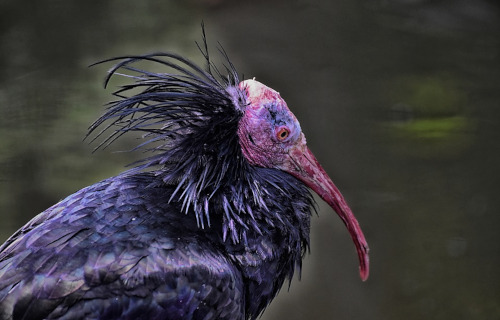
Northern Bald Ibis Facts
- Closing out this compliation of 3 Bewildering Birds of Africa comes the most physically unqiue of the choices, the Northern Bald Ibis.
- This visually distinctive avian remains best known by the descriptive common name for obvious reasons. It does have other, less frequently used non-technical names, though. These include the shorter monikers of the waldrapp and the hermit ibis.
- In scientific circles, however, it’s generally better known by its official title. That’s the somewhat hard to pronounce term of Geronticus eremita. Regardless of which name one chooses to use when referring to it, the bird represents an intriguing species.
- The animal owes its formal name to the efforts of a highly respected individual. That’s due to the fact that the eminent Swedish researcher, Carl Linnaeus, made the first official recognition of it as a separate and distinct species. This he managed in 1758.
- Sadly, its population numbers plummeted to fewer than 1,000 specimens in the wild in previous decades. Conservation and reintroduction efforts began in the 1990’s, however. Estimates also place around 2,000 individuals currently living in captivity.
- Due to its dire predicament, the IUCN originally listed the animal as Critically Endangered on its Red List. Thanks to the still ongoing efforts of several groups, the organization later upgraded that status. The creature now lists as Endangered.
- Understandably, given its delicate status, the Northern Bald Ibis faces numerous threats to its existence in the wild. Habitat loss and hunting natually represent serious dangers to the bird. Its greatest threat now, however, likely comes from climate change.
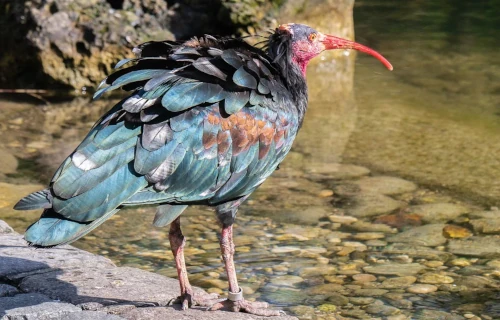
Northern Bald Ibis Physical Description
The remarkable Northern Bald Ibis quickly impresses those fortunate enough to encounter it, especially in the wild. Unlike some species, though, it does so for a combination of several reasons. One of those is its sheer physical size for a bird still capable of sustained flight.
Like many of its winged relatives, however, it does display a certain degree of the phsyiological trait of sexual dimorphism. In its case, this trait manifests itself in terms of simple physical dimensions. More precisely, males average a larger size than females.
That basic physical difference ranks as comparatively minor, though. Males of the somewhat surprising species attain an average wingspan measuring approximately 53 in (135 cm). Females of the animal, meanwhile, reach an average wingspan of only 49 in (125 cm).
In terms of plumage, at least, the genders remain virtually indistiguishable. This aspect presents as a predominantly black background. The feathers do, however, typically possess a slight iridescent quality. This generally appears as either a violet or a bronze-green.
Individuals of the Northern Bald Ibis also most commonly display one more gender-based physical difference. In this respect, the avian follows the pattern of other varieties of ibis. The beaks of the males grow to a greater length than those of their female counterparts.
Other noteworthy physical traits of the species include shorter legs than most ibises. But perhaps its most noteworthy visual trait centers on the head and face. These parts of the body display a lack of feathers, and obviously serves as the source of the common name.
- Kingdom: Animalia
- Phylum: Chordata
- Class: Aves
- Order: Pelecaniformes
- Family: Threskiornithidae
- Genus: Geronticus
- Species: G. erimita
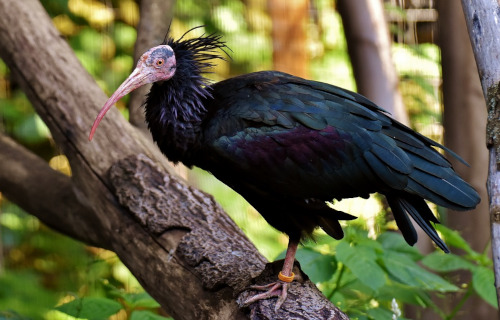
Northern Bald Ibis Distribution, Habitat, and Ecology
The Northern Bald Ibis currently lays claim to an extremely limited zone of habitation. That specific zone does remain well known for its remarkable species, however. That area of habitation, though, presently consist of a very small portion of the continent of Africa.
Presently, the visually distinctive animal appears in the wild only in the country of Morocco. Previously, however, it occupied a much more extensive range. That’s because populations of the animal once covered much of both Europe and portions of the Middle East.
Like most species, it displays decided preferences in its choice of habitat type. It does, however, further distinguish itself from its many cousins in this regard. Most other varieties of ibis prefer wetlands for their home. This bird, though, prefers undisturbed cliff ledges.
This particular environment also plays another role in its life cycle. That’s because the location places the population in close proximity to local areas of steppe. Such a precise and specific combination represents an important evolutionary requirement for this bird.
The Northern Bald Ibis feeds only in dry, now often grazed areas. This frequently consists of fallow fields and semi-arid steppes. Having evolved as a carnivore, it often consumes small prey, such as lizards and ground birds. It also consumes small invertebrates, such as snails.
The species also has a relatively gregarious nature and lives in small groups or colonies. Pairing typically occurs between 3-5 years of age. These birds usually mate for life, and both genders share in raising the young. In the wild, an average individual lives for 10 -15 years.
3 Bewildering Birds of Africa
We greatly hope that each of you completely enjoyed reading, and hopefully learning from, this article we’ve written about these 3 Bewildering Birds of Africa. It’s also our hope that doing so has left you with either a new or renewed appreciation for such wonders of Nature.
Unfortunately, however, many of their kindred around the world now find themselves facing strong threats to their continued existence as a species. Many of those dangers, in fact, stem from the actions of mankind. We must do all we can to protect and preserve them.
Check out our other articles on 5 Intriguing Insects of Greece, Wonderful Wild Cats of the World, 3 Manifestly Marveous Macropods, Fabulous Fungi Around the Globe
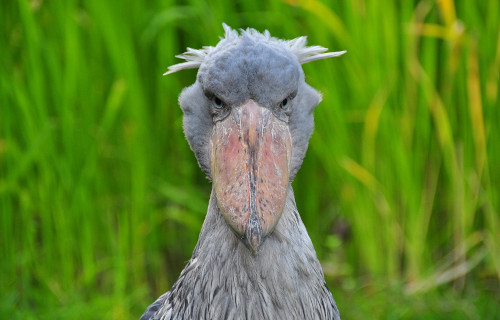
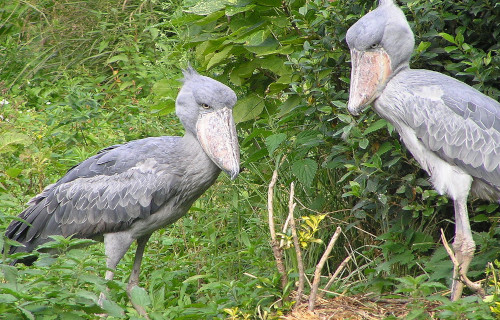
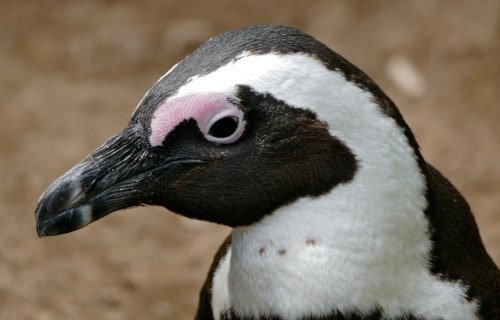
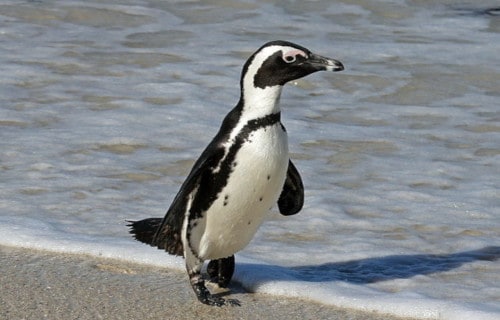









Leave a Reply